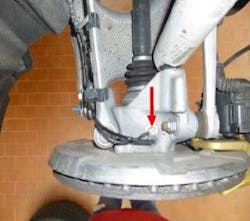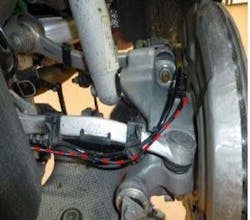This bulletin applies to 2017 and later BMW M5 sedan, M6 GranCoupe, M6 convertible and M6 Coupe vehicles.
The Dynamic Stability Control (DSC) warning light may be on while driving. The following DSC fault codes for the wheel speed sensors may be stored but cannot be cleared, even though the wheel speed sensors are working correctly and no wiring harness problems are found: 480712, 480715, 480718 and/or 48071B.
Due to high outside temperatures and extremely low atmospheric humidity, and electrostatic discharge (ESD) can occur in the wheel well area. This can transfer to the wheel speed sensors, causing irreparable damage to the DSC control unit.
Perform the vehicle test with ISTA/D and work through the corresponding DSC test modules. After completing the applicable test modules, and if the afore-noted DSC fault codes cannot be cleared, replace the DSC control unit and install ground retrofit kit P/N 61 13 7 856 494.
To improve conductivity, clean the contact area for the DSC bracket with sandpaper. Fit the short ground cable from the retrofit kit. Remove the wheel arch cover front section for the left front wheel.
Remove the right front wheel and wheel arch cover the front section. Using a suitable tool (flat countersink), machine the front contact area to bare metal on both the left and right sides of the body until they are smooth. Protect the reworked body attachment points using contact protection grease 83 19 2 295 229.
Use the existing mounting bolts to screw the ground the 750mm-long ground cable from the ESD ground cable and set it onto the relevant front wheel speed sensor and torque to 8 Nm.
Route the ground cable along the wheel speed sensor cable. Use an M6 x 14 hex bolt (9 905 525) and hex nut (9 815 702) to screw the ground cable end onto the prepared body attachment point. Secure the cable using cable straps (1 371 391).
Prepare the rear area by machining the body points bare and applying contact protection grease.





